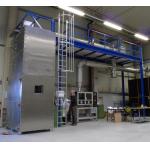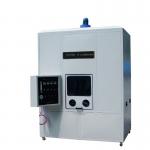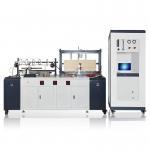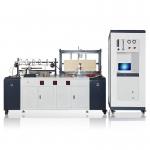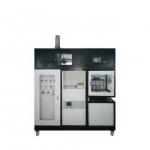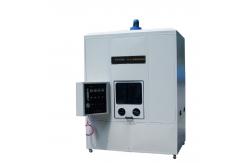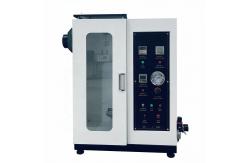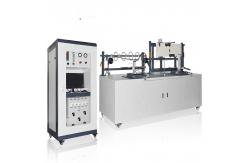In the realm of materials science and fire safety, understanding
the flammability of substances is of paramount importance. The
Customized Flammability Testing Apparatus is a cutting-edge
solution that empowers industries to accurately assess and manage
the fire risks associated with various materials. The Customized Flammability Testing Apparatus is a highly
specialized instrument designed to evaluate the flammability
characteristics of a wide range of materials, including plastics,
textiles, wood, and chemicals. It caters to the needs of industries
such as manufacturing, construction, automotive, and aerospace, as
well as research institutions and regulatory bodies. The primary
objective is to determine key parameters like ignition temperature,
flame spread rate, heat release rate, and the ability of a material
to self-extinguish. This data is crucial for product design,
quality control, and ensuring compliance with fire safety
regulations. - Robust and Heat-Resistant Construction
- The apparatus is built with a heavy-duty stainless steel frame that
can withstand the rigors of high-temperature testing. The interior
chamber is lined with a refractory material, capable of
withstanding temperatures up to 1500°C. The door is a
double-layered, insulated structure with a reliable sealing
mechanism to prevent heat and gas leakage. A small, heat-resistant
viewing window, made of tempered glass or a ceramic material,
allows for visual inspection during the test without compromising
the integrity of the test environment.
- Precision Temperature and Flame Control
- Temperature Control: The apparatus can precisely regulate the
temperature within the testing chamber, ranging from ambient
temperature to 1200°C, with an accuracy of ±3°C. It utilizes
advanced heating elements, such as silicon carbide heaters, and a
sophisticated PID (Proportional-Integral-Derivative) control
system. Multiple thermocouples are strategically placed to ensure
uniform temperature distribution and accurate temperature
monitoring. The user-friendly control panel enables the programming
of complex temperature profiles, including ramping, holding, and
cycling, to mimic different fire scenarios.
- Flame Generation and Control: The flame system is highly
adjustable. It can produce flames of varying intensities, from a
gentle pilot flame to a powerful, turbulent flame. The fuel supply,
which can be propane, methane, or other combustible gases, is
precisely metered using high-precision flow regulators. The
air-fuel ratio can be adjusted within a wide range, allowing for
the customization of the flame's oxidizing or reducing
characteristics. This flexibility is essential for testing the
response of materials to different types of flames, such as the
slow-burning flames of a smoldering fire or the intense heat of a
flashover.
- Advanced Instrumentation and Data Acquisition
- The apparatus is equipped with a comprehensive suite of sensors and
measurement devices. In addition to temperature and flame sensors,
it includes optical sensors for monitoring flame height,
luminosity, and color. Smoke density sensors, based on light
scattering or absorption principles, accurately measure the amount
and density of smoke produced. Gas sensors are incorporated to
detect and analyze the composition of gases emitted during
combustion, such as carbon monoxide, carbon dioxide, and volatile
organic compounds. These sensors are connected to a high-speed data
acquisition system that records and stores all relevant data. The
data acquisition system offers a sampling rate of up to 5000
samples per second, ensuring that even the most transient and
minute changes in parameters are captured. The collected data can
be analyzed in real-time or retrieved later for in-depth studies
using specialized software, which provides detailed reports and
graphical representations of the test results.
- Versatile Testing Modes and Configurations
- The Customized Flammability Testing Apparatus offers a variety of
testing modes to accommodate different sample types and testing
requirements. It can perform horizontal and vertical flame spread
tests, where the behavior of a material's surface as the flame
travels across it is evaluated. It can also conduct oxygen index
tests to determine the minimum concentration of oxygen required to
support combustion. Additionally, the apparatus can be configured
for small-scale fire resistance tests, such as testing the
integrity of a single component or a small assembly under fire
conditions. The apparatus can be integrated with other
environmental control systems, such as humidity and pressure
control, to study the combined effects of multiple factors on
flammability.
- Compliance with Industry Standards
- The apparatus is designed to comply with a multitude of
international and national flammability testing standards. It
adheres to ASTM (American Society for Testing and Materials)
standards, such as ASTM D635 for horizontal burning rate, ASTM
D3801 for vertical burning rate, and ASTM E662 for smoke density.
It also meets ISO (International Organization for Standardization)
standards, including ISO 4589 for oxygen index determination and
ISO 5658 for flame spread. This compliance ensures that the test
results are widely recognized and accepted by regulatory bodies and
industry peers, facilitating product certification and market
access.
- Chamber Size and Capacity
- The apparatus is available in different chamber sizes to suit
various sample sizes and testing volumes. Smaller chambers may have
interior dimensions of 0.3 meters x 0.3 meters x 0.3 meters,
suitable for testing small specimens or individual components.
Medium-sized chambers can measure 0.6 meters x 0.6 meters x 0.6
meters, providing sufficient space for testing larger samples or a
batch of products. Larger chambers, with dimensions exceeding 1
meter x 1 meter x 1 meter, are ideal for full-scale testing of
building materials or large industrial products. The interior
volume and shape are carefully designed to ensure proper air
circulation and uniform exposure of the sample to the fire and
environmental conditions.
- Temperature Range and Accuracy
- As mentioned earlier, the temperature can be controlled from
ambient to 1200°C, with an accuracy of ±3°C. The temperature ramp
rate can be adjusted from 1°C per minute to 100°C per minute,
allowing for the simulation of both slow and rapid temperature
changes. For example, a slow ramp rate may be used to study the
thermal degradation of a material over time, while a rapid ramp
rate can mimic the sudden heat increase during a fire outbreak.
- Flame Intensity and Control Parameters
- The flame intensity can be adjusted over a wide range, with a
maximum heat output equivalent to several megawatts per square
meter. The fuel flow rate can be varied from a few milliliters per
minute to several liters per minute, and the air-fuel ratio can be
precisely controlled within a range of 1:1 to 20:1. These
parameters enable the creation of flames with different
characteristics, from a small, stable flame for precision testing
to a large, turbulent flame for more severe fire simulations.
- Data Acquisition Rate and Resolution
- The data acquisition system samples sensor data at a rate of 5000
samples per second. The temperature sensor has a resolution of
0.1°C, the smoke density sensor can detect changes as small as
0.01% opacity, and the gas sensors have a sensitivity in the parts
per million (ppm) range for most common gases. This high-resolution
and high-speed data capture ensure that the apparatus provides
detailed and accurate information about the flammability
characteristics of the tested samples.
- Compliance with Key Flammability Testing Standards
- The apparatus complies with ASTM D635, ASTM D3801, ASTM E662, ISO
4589, and ISO 5658, among other relevant standards. It can also be
customized to meet specific requirements of other industry
standards or regulatory codes, ensuring its adaptability to
different industries and applications.
- Accurate Simulation of Flammability Scenarios
- The primary function of the apparatus is to provide a highly
accurate and realistic simulation of flammability conditions. By
precisely controlling temperature, flame characteristics, and other
environmental factors, it allows for the comprehensive evaluation
of how materials will behave in an actual fire. For example, it can
determine if a textile will quickly catch fire and spread flames,
if a plastic will release toxic gases when burned, or if a building
material will maintain its structural integrity under fire
exposure. This information is invaluable for manufacturers to make
informed decisions about material selection, product design, and
safety enhancements.
- Enhanced Product Development and Quality Assurance
- Through detailed flammability testing, manufacturers can identify
and address potential fire safety issues in their products. If a
material shows a high flammability index or poor self-extinguishing
ability, appropriate modifications can be made, such as adding fire
retardants, changing the material composition, or improving the
product's design. This leads to the development of safer and more
reliable products, reducing the risk of fire-related accidents and
ensuring customer satisfaction. The apparatus also serves as a
crucial tool for quality control, ensuring that each batch of
products is tested and compliant, thereby reducing the risk of
product recalls and enhancing brand reputation.
- Facilitation of Regulatory Compliance and Certification
- Regulatory bodies rely on accurate and standardized flammability
test results to enforce fire safety regulations. The Customized
Flammability Testing Apparatus enables manufacturers to conduct
tests in accordance with recognized industry standards, providing
the necessary data for regulatory compliance and product
certification. This helps in streamlining the approval process,
ensuring that products can be legally marketed and used in various
applications, from residential and commercial buildings to
industrial facilities and transportation vehicles.
- Stringent Manufacturing Process
- The flammability testing apparatus is manufactured under strict
quality control procedures. Each component, from the heating
elements and sensors to the control panel and chamber lining, is
carefully sourced and inspected for quality and performance. The
assembly process is carried out by highly trained technicians in a
clean and controlled environment. The apparatus undergoes a series
of calibration and validation tests during the manufacturing
process to ensure that it meets the required accuracy and
performance standards.
- The calibration of temperature, flame, and other sensors is a
critical part of the manufacturing process. It is performed using
traceable reference standards that are calibrated to the highest
levels of accuracy, guaranteeing the reproducibility of the test
results. Rigorous quality audits and inspections are conducted at
various stages of production to maintain the highest level of
product quality and compliance with flammability testing standards.
- Quality Certification and Validation
Our apparatus has obtained relevant quality certifications and has
been validated by independent fire testing laboratories. It has
been proven to provide accurate and reliable test results,
conforming to the relevant industry standards. We also continuously
update and improve our product based on the latest technological
advancements and customer feedback from the fire safety industry to
ensure its long-term performance and compliance.
- Textile Industry
- A textile manufacturer used the Customized Flammability Testing
Apparatus to test a new line of upholstery fabrics. The tests
revealed that some fabrics had a high flame spread rate and
released toxic gases when burned. By using fire-retardant
treatments and modifying the fabric composition, they were able to
improve the flammability characteristics of the fabrics, making
them safer for use in furniture and interior applications.
- A clothing brand tested their new outdoor apparel fabrics. The
testing identified that a particular fabric had a low ignition
temperature, which could be a safety hazard. By adding a
flame-resistant coating and retesting, they were able to enhance
the fabric's fire safety and market it as a more reliable option
for outdoor activities.
- Plastics and Polymer Industry
- A plastics manufacturer tested a new type of plastic resin. The
apparatus showed that the resin had a poor self-extinguishing
ability and released a large amount of smoke when burned. By
incorporating fire retardant additives and adjusting the
manufacturing process, they were able to produce a modified resin
with improved flammability properties, suitable for use in
electrical enclosures and other applications where fire safety is
crucial.
- A polymer research institution used the apparatus to study the
flammability of a new biodegradable polymer. The detailed data
obtained from the tests helped them understand the polymer's
combustion behavior and develop strategies to enhance its fire
resistance, opening up new possibilities for sustainable and
fire-safe polymer applications.
- Construction and Building Materials
- A building materials supplier tested a new insulation material. The
testing determined that the material had a relatively high heat
release rate, which could contribute to the spread of fire in a
building. By using a different filler material and improving the
manufacturing process, they were able to reduce the heat release
rate and improve the fire performance of the insulation, meeting
the requirements of building codes and enhancing the safety of
building occupants.
- A flooring manufacturer tested different types of laminate
flooring. The Customized Flammability Testing Apparatus helped them
identify the most fire-resistant options, allowing them to market
their products with confidence and comply with safety regulations
for residential and commercial flooring.
- Pre-Sales Technical Consultation
Our team of fire safety experts provides in-depth technical
consultations to help customers understand the capabilities and
suitability of the Customized Flammability Testing Apparatus for
their specific testing needs. We offer demonstrations and training,
tailored to the fire safety industry, to familiarize customers with
the operation and functionality of the equipment before purchase.
We also assist in selecting the appropriate test methods and
accessories based on the materials to be tested. - After-Sales Service and Maintenance
We offer comprehensive after-sales service, including on-site
installation and commissioning. Our technicians are available for
regular maintenance, calibration, and emergency repairs. We provide
spare parts and upgrades to keep the test apparatus operating at
peak performance. We also offer service contracts that include
preventive maintenance and priority technical support, ensuring the
long-term reliability and availability of the equipment for
flammability testing. - Training and Technical Support
We conduct training programs for new users to ensure they can
effectively operate the Customized Flammability Testing Apparatus
and interpret the test results. Our technical support team is
available 24/7 to answer questions, provide troubleshooting
assistance, and offer guidance on test method optimization and
compliance with flammability testing standards. We also provide
software updates and support for the data acquisition and analysis
systems, enabling customers to take full advantage of the latest
features and technologies in flammability testing.
The Customized Flammability Testing Apparatus is an essential asset
for any organization involved in fire safety testing and product
development. If you are looking to enhance your flammability
testing capabilities, ensure compliance with industry standards, or
drive innovation in fire safety, this is the ideal solution.
Contact us today to learn more and get a customized quotation. Let
us help you unlock the full potential of your flammability testing
and product quality assurance |

